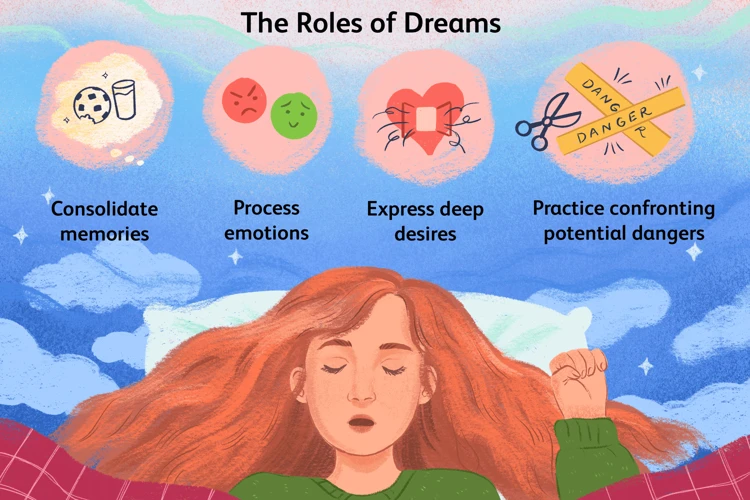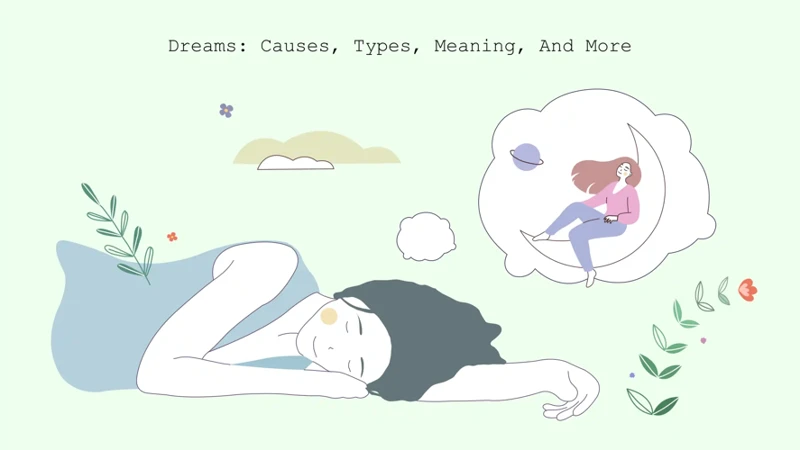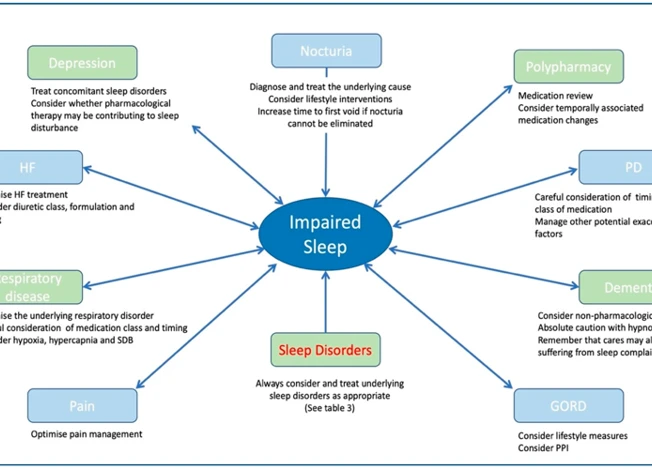Many people have experienced the discomfort of waking up from a terrifying nightmare, heart pounding and covered in sweat. But what if these nightmares are not just random figments of our imagination? What if they are actually related to underlying sleep disorders? In this article, we will delve into the fascinating world of sleep disorders and their connection to nightmares. We will explore the basics of sleep disorders, their common types, and the definition of nightmares. We will examine the causative factors behind nightmares and how sleep disorders can exacerbate them. By the end, you will have a comprehensive understanding of the intricate relationship between sleep disorders and nightmares, as well as potential avenues for managing these sleep-related disturbances. So buckle up and get ready to explore the hidden depths of our sleeping minds.
The Basics of Sleep Disorders

Sleep disorders can disrupt the delicate balance of our natural sleep patterns, leaving us feeling exhausted and unable to function at our best. These disorders come in various forms, each with their own unique symptoms and effects on our overall well-being. Sleep disorders encompass a range of conditions that interfere with our ability to fall asleep, stay asleep, or achieve deep and restful sleep. Some of the most common types include insomnia, sleep apnea, narcolepsy, and restless leg syndrome. These disorders can be caused by a multitude of factors, such as stress, anxiety, medical conditions, or even certain medications. Understanding the basics of sleep disorders is crucial in order to address them effectively and improve the quality of our sleep. By addressing these underlying disorders, we may also be able to alleviate the frequency and intensity of nightmares that can have a detrimental impact on our mental health and well-being.
What are Sleep Disorders?
Sleep disorders refer to a diverse array of conditions that disrupt the normal sleep patterns of individuals. These disorders can cause problems with falling asleep, staying asleep, or experiencing restful sleep, leading to impaired daytime functioning. Insomnia, one of the most prevalent sleep disorders, is characterized by difficulty falling asleep or staying asleep, resulting in inadequate sleep duration or poor sleep quality. Sleep apnea is another common disorder that involves interrupted breathing during sleep, leading to fragmented sleep and daytime fatigue. Narcolepsy, on the other hand, is a neurological disorder characterized by excessive daytime sleepiness and sudden uncontrollable sleep attacks. Restless leg syndrome causes uncomfortable sensations in the legs, often worsening at night, causing an irresistible urge to move them, which can disrupt sleep. Other sleep disorders include sleepwalking, night terrors, and sleep paralysis. These conditions can arise from a variety of causes, including medical conditions, medications, lifestyle factors, and underlying mental health issues. Understanding the nature of these sleep disorders is crucial in order to seek appropriate treatment and improve overall sleep quality, which can have a significant impact on mental health and well-being, including the frequency and intensity of nightmares (source).
Common Types of Sleep Disorders
- Insomnia: Insomnia is one of the most common sleep disorders, characterized by difficulty falling asleep, staying asleep, or experiencing non-restorative sleep. It can be caused by various factors such as stress, anxiety, medications, or underlying medical conditions.
- Sleep Apnea: Sleep apnea is a disorder where breathing repeatedly stops and starts during sleep. This can lead to fragmented sleep and daytime fatigue. Obstructive sleep apnea is the most common type, caused by the relaxation of the throat muscles during sleep, resulting in blocked airways.
- Narcolepsy: Narcolepsy is a neurological disorder that affects the brain’s ability to regulate sleep-wake cycles. People with narcolepsy may experience excessive daytime sleepiness, sudden or uncontrollable episodes of falling asleep, and muscle weakness or paralysis during sleep.
- Restless Leg Syndrome (RLS): RLS is a condition characterized by an irresistible urge to move the legs, often accompanied by uncomfortable or unpleasant sensations. These sensations typically worsen at night, leading to difficulty falling asleep or staying asleep.
- Parasomnias: Parasomnias are a group of sleep disorders that involve abnormal movements, behaviors, emotions, perceptions, or dreams during sleep. Examples include sleepwalking, sleep terrors, sleep-related eating disorder, and REM sleep behavior disorder.
Understanding the different types of sleep disorders is essential in identifying the specific issues one may experience. Each disorder has its own unique characteristics and treatment approaches. It is important to consult with a healthcare professional to diagnose and develop an appropriate treatment plan for improving sleep quality and managing any associated negative effects on mental health and well-being. Additionally, addressing sleep disorders can also have a positive impact on the frequency and intensity of nightmares, as they can often be linked to disrupted sleep patterns as well as emotional and memory processing during sleep (source).
Understanding Nightmares

A nightmare is a distressing dream that often elicits feelings of fear, anxiety, and unease. These vivid and often bizarre dreams can occur during REM (rapid eye movement) sleep, which is the stage of sleep where most dreaming takes place. Nightmares can be extremely realistic and may result in the individual waking up feeling overwhelmed and unsettled. They can be influenced by a variety of factors, including emotions, past experiences, and memories. Nightmares tend to be more common in children, but can also affect adults. They can range from mild and infrequent occurrences to frequent and recurring nightmares that significantly disrupt sleep quality. Nightmares may be symbolic representations of fears, unresolved traumas, or subconscious anxieties. It is important to understand the causes and potential impact of nightmares in order to develop strategies for managing and improving sleep quality.
What are Nightmares?
Nightmares are vivid and disturbing dreams that can cause intense fear, anxiety, and distress during sleep. These unsettling dreams often involve threatening situations, such as being chased, attacked, or trapped. During a nightmare, the dreamer may experience a range of intense emotions and physical sensations, including a racing heart, sweating, and a sense of impending doom. The content of nightmares can vary greatly from person to person, but common themes include falling, being naked in public, or the loss of a loved one. These dreams typically occur during the rapid eye movement (REM) stage of sleep, which is a deep sleep phase associated with vivid dreaming. It is believed that nightmares serve as a manifestation of our fears, anxieties, and unresolved emotions. They may also be influenced by external factors such as stress, trauma, or underlying psychological disorders. While occasional nightmares are normal, frequent and distressing nightmares can significantly impact our sleep quality and overall well-being. Understanding the nature of nightmares is the first step toward addressing them effectively and finding ways to reduce their frequency and intensity.
Causes of Nightmares
Nightmares can be triggered by a variety of factors. One possible cause is psychological stress, which can manifest itself in dreams during our sleep. Stressful events or experiences, such as trauma, anxiety, or grief, can influence the content and intensity of nightmares. Additionally, individuals with certain mental health conditions, such as depression or post-traumatic stress disorder (PTSD), may be more prone to experiencing nightmares. Environmental factors can also play a role in the occurrence of nightmares. For example, sleeping in a noisy or uncomfortable environment can disrupt the sleep cycle and lead to more frequent nightmares. Medications can also be a potential cause of nightmares, as certain medications can affect brain activity during sleep. Substances like alcohol and recreational drugs can also contribute to vivid and disturbing dreams. Another possible cause of nightmares is physical illness. Fever, infections, and other medical conditions can disrupt sleep patterns and increase the likelihood of nightmares. Lastly, sleep disorders themselves, such as sleep apnea or insomnia, can contribute to the development of nightmares. It is worth noting that the causes of nightmares can vary from person to person, and multiple factors may be at play in any given individual. Understanding these causes can help individuals identify and address potential triggers, leading to a better night’s sleep.
The Relationship Between Sleep Disorders and Nightmares

The relationship between sleep disorders and nightmares is a complex and interwoven one. Sleep disorders can significantly impact the occurrence and content of our dreams, leading to an increased likelihood of experiencing nightmares. Sleep disorders such as insomnia can disrupt the natural sleep cycle, leading to fragmented sleep and REM sleep deprivation. This can result in more vivid and intense dreams, including nightmares. Additionally, sleep disorders can contribute to heightened levels of stress, anxiety, and emotional instability, which are known triggers for nightmares. Studies have shown that individuals with sleep disorders are more likely to report nightmares compared to those without sleep disturbances. The impact of sleep disorders on nightmares is not only limited to frequency but can also influence the severity and emotional intensity of the dreams. Recognizing and addressing sleep disorders is therefore crucial in managing and alleviating the occurrence of nightmares, promoting better sleep quality, and overall well-being.
Impact of Sleep Disorders on Nightmares
The impact of sleep disorders on nightmares is profound and multifaceted. Sleep disorders can disrupt the normal sleep architecture, leading to fragmented and disturbed sleep cycles. When the natural sleep patterns are interrupted, it can result in an increase in vivid and intense dreams, including nightmares. Sleep disorders such as insomnia, sleep apnea, and narcolepsy can contribute to the development and recurrence of nightmares. Insomnia, characterized by difficulty falling asleep or staying asleep, can lead to an imbalance in sleep stages, causing individuals to spend less time in restorative REM sleep, which is associated with dreaming. This disruption can increase the likelihood of experiencing distressing dreams and nightmares. Sleep apnea, a condition where breathing is repeatedly interrupted during sleep, can also impact the occurrence of nightmares. The interrupted breathing can cause sudden arousals, leading to a higher frequency of REM sleep periods, which are associated with intense dreaming. The fragmented sleep caused by sleep apnea can trigger sleep deprivation, which can further exacerbate the occurrence of nightmares. Narcolepsy, a neurological disorder characterized by excessive daytime sleepiness and sudden sleep attacks, can also influence the occurrence and content of nightmares. The disrupted sleep-wake cycles and abnormal REM sleep patterns in narcolepsy patients can lead to an increase in REM sleep-related phenomena, including vivid dreams and nightmares. The impact of sleep disorders on nightmares is significant, as it can disrupt sleep quality, contribute to emotional distress, and negatively impact overall well-being. By effectively managing and treating sleep disorders, individuals may experience a reduction in nightmares and an improvement in their overall sleep quality and mental health.
Research Findings
Research findings have shed light on the intricate connection between sleep disorders and nightmares. Numerous studies have been conducted to explore the relationship and potential causative factors. One study published in the Journal of Sleep Research found that individuals with sleep disorders, such as insomnia or sleep apnea, were more likely to experience frequent nightmares compared to those without sleep disorders. Another study conducted at a sleep clinic revealed that treating underlying sleep disorders significantly reduced the occurrence of nightmares in individuals. Research has shown that certain medications used to treat sleep disorders, such as certain antidepressants or anti-anxiety medications, can actually increase the occurrence of nightmares. This highlights the importance of seeking appropriate treatment options for sleep disorders to alleviate both the disorder itself and the associated nightmares. While more research is still needed to fully understand the intricacies of this relationship, these findings provide valuable insight into the impact of sleep disorders on nightmares and the potential avenues for managing both.
Case Studies
Case studies provide valuable insights into the relationship between sleep disorders and nightmares by examining real-life scenarios and their outcomes. One such case involved a 35-year-old woman who experienced frequent nightmares and disrupted sleep patterns. Through a thorough evaluation, it was discovered that she suffered from sleep apnea, a disorder in which breathing repeatedly stops and starts during sleep. Treatment for her sleep apnea, including the use of a continuous positive airway pressure (CPAP) machine, resulted in a significant improvement in her sleep quality and a reduction in her nightmares. Another case study involved a 50-year-old man who had been struggling with insomnia for several years. His lack of sleep not only affected his daily functioning but also contributed to an increase in distressing nightmares. After receiving cognitive-behavioral therapy for insomnia, his sleep improved, leading to a decrease in the frequency and intensity of his nightmares. These case studies highlight the direct correlation between addressing sleep disorders and the improvement of nightmare-related symptoms. By addressing the underlying sleep disorder, individuals can experience relief from nightmares and achieve better quality sleep.
Recognizing Sleep Disorders and Their Symptoms

Recognizing sleep disorders and their symptoms is essential in order to seek appropriate medical intervention and improve our sleep quality. Sleep disorders manifest in various ways, and being aware of the signs and symptoms can help us identify a potential problem. Some common indicators of sleep disorders include difficulty falling asleep or staying asleep, excessive daytime sleepiness, loud snoring, gasping or choking during sleep, and frequent awakenings during the night. Additionally, individuals with sleep disorders may experience restless legs, nightmares, sleepwalking, or even episodes of suddenly falling asleep during the day. It’s important to note that these symptoms may vary depending on the specific sleep disorder a person is experiencing. If any of these symptoms persist and significantly impact daily life, it’s crucial to consult a healthcare professional to determine the underlying cause and develop an appropriate treatment plan.
Identifying Sleep Disorders
Identifying sleep disorders can be challenging as the symptoms may vary depending on the specific disorder. However, there are certain common signs that can help in the identification process. Here are some key indicators to look out for when trying to identify sleep disorders:
1. Persistent Fatigue: Feeling excessively tired and fatigued even after a full night’s sleep can be a sign of a sleep disorder.
2. Trouble Falling or Staying Asleep: Difficulty falling asleep or frequent awakenings throughout the night can indicate the presence of a sleep disorder.
3. Daytime Sleepiness: Excessive daytime sleepiness, regardless of the amount of sleep obtained, is a common symptom of sleep disorders.
4. Loud Snoring: Chronic loud snoring can be indicative of conditions such as sleep apnea, a disorder characterized by pauses in breathing during sleep.
5. Restless Leg Syndrome: An irresistible urge to move one’s legs, often accompanied by uncomfortable sensations, can be a sign of restless leg syndrome.
6. Insomnia: Difficulty falling asleep, staying asleep, or waking up too early on a regular basis may suggest the presence of insomnia.
7. Sleepwalking or Night Terrors: Engaging in complex activities during sleep or experiencing intense episodes of fear during the night may be indicative of sleepwalking or night terrors.
It is important to remember that the presence of these symptoms does not necessarily confirm the presence of a sleep disorder. A comprehensive evaluation and diagnosis by a medical professional specializing in sleep disorders, such as a sleep specialist or neurologist, is essential for accurate identification and treatment.
Signs and Symptoms of Sleep Disorders
There are several signs and symptoms that can indicate the presence of a sleep disorder. One common sign is difficulty falling asleep or staying asleep, known as insomnia. Individuals with insomnia may struggle to fall asleep despite feeling tired, or they may wake up frequently during the night and have difficulty getting back to sleep. Another symptom is excessive daytime sleepiness, where individuals feel excessively tired or fatigued during the day, regardless of how much sleep they got the night before. This can lead to difficulties concentrating, decreased productivity, and even drowsiness while driving or operating machinery. Sleep disorders may also manifest as abnormal behaviors during sleep, such as snoring loudly, gasping for air, or experiencing sudden jerks or movements. These behaviors can indicate conditions like sleep apnea or restless leg syndrome. Additionally, individuals with sleep disorders may experience morning headaches, difficulty waking up in the morning, or a lack of refreshed feeling upon waking. It’s important to note that while these signs and symptoms may indicate the presence of a sleep disorder, a proper diagnosis by a healthcare professional is necessary for accurate identification and treatment.
Managing Sleep Disorders to Alleviate Nightmares
Managing sleep disorders is crucial for alleviating the frequency and severity of nightmares that can disrupt our sleep and affect our overall well-being. There are several strategies and treatment options available to help individuals with sleep disorders improve their sleep hygiene and reduce the occurrence of nightmares. Treatment options can range from medication to therapy, depending on the specific sleep disorder. Medications such as sedatives or antidepressants may be prescribed to address underlying conditions that contribute to sleep disturbances. Additionally, improving sleep hygiene is essential for better sleep quality. This includes establishing a regular sleep schedule, creating a comfortable sleep environment, and avoiding stimulants like caffeine and electronic screens before bedtime. Behavioral techniques such as relaxation exercises, meditation, and cognitive-behavioral therapy can also be effective in managing nightmares. By taking a comprehensive approach to managing sleep disorders, individuals can greatly improve their overall sleep quality and reduce the impact of nightmares on their mental and emotional well-being.
Treatment Options for Sleep Disorders
When it comes to treating sleep disorders, there are a variety of options available that can help individuals regain a healthy and restful sleep pattern. Treatment options for sleep disorders can range from medical interventions to lifestyle changes and behavioral therapies. In cases of sleep apnea, continuous positive airway pressure (CPAP) machines are commonly used to help keep the airways open during sleep. Medications may be prescribed for certain sleep disorders, such as insomnia or restless leg syndrome, to address underlying causes or symptoms. However, it is important to note that medication should be used under the guidance of a healthcare professional. In addition to medical interventions, lifestyle modifications can play a significant role in managing sleep disorders. This can include maintaining a consistent sleep schedule, creating a relaxing bedtime routine, and optimizing the sleep environment. Behavioral techniques, such as cognitive-behavioral therapy for insomnia (CBT-I), can also be effective in addressing sleep disorders by identifying and modifying negative thoughts and behaviors related to sleep. The treatment approach for sleep disorders should be individualized and may involve a combination of different strategies based on the specific diagnosis and needs of the individual. Seeking the guidance of a healthcare professional or sleep specialist is crucial in developing an appropriate treatment plan that can lead to better sleep and improved overall well-being.
Improving Sleep Hygiene
Improving sleep hygiene is essential for maintaining healthy sleep patterns and reducing the occurrence of nightmares. Here are some practical tips and strategies to enhance sleep hygiene:
1. Stick to a Consistent Sleep Schedule: Establish a regular sleep routine by going to bed and waking up at the same time every day, even on weekends. This helps regulate your internal body clock and promotes better quality sleep.
2. Create a Relaxing Sleep Environment: Make your bedroom a calm and comfortable space for sleep. Keep the room cool, dark, and quiet. Use blackout curtains, earplugs, or a white noise machine to minimize external disruptions.
3. Avoid Stimulating Activities Before Bed: Engaging in stimulating activities right before sleep can hinder the ability to fall asleep. Avoid using electronic devices like smartphones or tablets, as the blue light emitted can suppress the sleep hormone melatonin. Instead, engage in relaxing activities such as reading a book or taking a warm bath.
4. Maintain a Healthy Lifestyle: Regular exercise during the day can promote better sleep at night. However, avoid intense workouts close to bedtime as this can increase alertness. Additionally, limit caffeine and alcohol intake, as they can interfere with sleep patterns.
5. Establish a Pre-Sleep Routine: Wind down before bed by establishing a calming bedtime routine. This may include activities such as listening to soothing music, practicing relaxation techniques like deep breathing or meditation, or enjoying a cup of caffeine-free herbal tea.
6. Limit Daytime Napping: If you have trouble falling asleep at night, try to avoid daytime napping or limit it to short power naps of around 20 minutes. This helps consolidate sleep during the night and prevent disruption to your sleep schedule.
By incorporating these sleep hygiene practices into your daily routine, you can create an environment that promotes restful and rejuvenating sleep. Improving sleep hygiene not only enhances overall sleep quality but also plays a significant role in reducing the frequency and intensity of nightmares.
Behavioral Techniques for Nightmare Prevention
Behavioral techniques offer effective strategies to prevent nightmares and improve the quality of sleep. One such technique is Imagery Rehearsal Therapy (IRT). In this approach, individuals are encouraged to rewrite the narrative of their nightmares, transforming them into more positive and less distressing dreams as they imagine them before falling asleep. This process helps to desensitize the mind to the fear and anxiety associated with the nightmares, allowing for a more peaceful sleep experience. Another technique is Progressive Muscle Relaxation (PMR), which involves systematically tensing and relaxing different muscle groups to induce a state of relaxation before bedtime. By reducing overall muscle tension and promoting relaxation, PMR can help alleviate the physical and psychological stress that can contribute to nightmares. Additionally, Sleep Restriction is a behavioral technique that involves limiting the amount of time spent in bed to increase sleep efficiency. This technique helps consolidate sleep and reduce nighttime awakenings, which can disrupt sleep and potentially contribute to nightmares. Finally, Establishing a Bedtime Routine can signal to the body and mind that it is time to unwind and prepare for sleep. Engaging in relaxing activities before bed, such as reading a book, taking a warm bath, or practicing mindfulness exercises, can promote a sense of calm and tranquility, reducing the likelihood of nightmares. By incorporating these behavioral techniques into daily routines, individuals can take proactive steps to prevent nightmares and improve their overall sleep quality.
Conclusion
In conclusion, understanding the relationship between sleep disorders and nightmares can provide valuable insights into managing these disruptive sleep disturbances. Sleep disorders such as insomnia, sleep apnea, narcolepsy, and restless leg syndrome can significantly impact our sleep quality and duration, leading to an increased likelihood of experiencing nightmares. Research findings and case studies have shown that individuals with sleep disorders are more prone to having intense and vivid nightmares. These nightmares can further disrupt sleep and contribute to a vicious cycle of poor sleep and increased daytime fatigue.
Recognizing the signs and symptoms of sleep disorders is key to early intervention and effective treatment. Seeking professional help and undergoing appropriate diagnostic tests can help identify the specific sleep disorder and provide tailored treatment options. Managing sleep disorders through various approaches, including medication, behavioral techniques, and improving sleep hygiene, can alleviate the frequency and intensity of nightmares. Research has shown that improving sleep quality and addressing sleep disorders can have a positive impact on overall mental health and well-being.
It is essential to prioritize sleep health and seek support when facing sleep disturbances and nightmares. Creating a sleep-friendly environment, practicing relaxation techniques, and maintaining a consistent sleep schedule can all contribute to a better quality of sleep and reduced likelihood of experiencing nightmares. Remember, addressing sleep disorders and improving sleep hygiene can lead to better overall sleep and a healthier mind.
In summary, by addressing sleep disorders and implementing strategies to manage them, we can enhance the quality of our sleep and potentially decrease the occurrence of nightmares. Sleep is a vital aspect of our well-being, and nurturing healthy sleep habits can promote optimal physical and mental health. So let’s prioritize our sleep and take steps towards a peaceful and nightmare-free slumber.
Frequently Asked Questions
What role does sleep play in our overall health?
Sleep plays a vital role in our overall health and well-being. It allows our body and mind to rest, recover, and rejuvenate. During sleep, our immune system is strengthened, our memory is consolidated, and our emotions are regulated.
Can sleep disorders contribute to the development of mental health issues?
Yes, sleep disorders can contribute to the development of mental health issues. Poor sleep has been linked to increased risk of anxiety disorders, depression, and other psychiatric conditions. It is important to address sleep disorders to support our mental well-being.
Is there a link between sleep disorders and cardiovascular health?
Yes, there is a link between sleep disorders and cardiovascular health. Certain sleep disorders, like sleep apnea, can increase the risk of high blood pressure, heart disease, and stroke. Treating sleep disorders can help reduce these cardiovascular risks.
Do sleep disorders affect children as well?
Yes, sleep disorders can also affect children. Conditions like insomnia, sleepwalking, and night terrors can disrupt a child’s sleep and impact their overall health and development. Identifying and managing sleep disorders in children is important for their well-being.
Can medication be a cause of sleep disorders?
Yes, certain medications can cause or contribute to sleep disorders. Stimulant medications, antidepressants, and some allergy medications can interfere with sleep patterns. It is important to discuss any sleep-related side effects with your doctor.
Is it possible to have more than one type of sleep disorder?
Yes, it is possible to have more than one type of sleep disorder. Sleep disorders can coexist or overlap, making it important to properly diagnose and treat each condition individually for optimal sleep health.
Can sleep disorders be inherited?
There can be a genetic component to sleep disorders, making them somewhat inheritable. For example, narcolepsy and insomnia have been found to run in families. However, other factors like lifestyle and environment also play a role.
Are there natural remedies that can help with sleep disorders?
There are several natural remedies that can help manage sleep disorders. Practices like maintaining a consistent sleep schedule, creating a relaxing bedtime routine, and avoiding stimulating activities before bed can promote better sleep. Other options include relaxation techniques, herbal supplements, and meditation.
Can changing our sleep environment improve sleep disorders?
Yes, changing our sleep environment can improve sleep disorders. Creating a dark, quiet, and comfortable sleep environment can promote better sleep quality. Using tools like earplugs, eye masks, or white noise machines can also help optimize our sleep environment.
Is it necessary to consult a healthcare professional for sleep disorders?
It is highly recommended to consult a healthcare professional for sleep disorders. They can help diagnose the underlying cause of the sleep disorder and recommend appropriate treatment options. A healthcare professional can also assess any potential impacts on your overall health and well-being.








